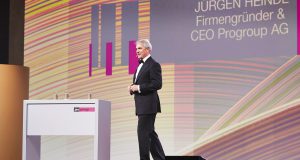MARKO JÄMSÉN
Gratkorn, a small suburb of Graz, is a picturesque and historic setting in the gentle Styrian landscape of southern Austria, on the river Mur. Paper has been produced at Gratkorn for more than four centuries, with the first records of printing and paper manufacturing in the 16th century. Fast-forward to the 20th century, and this historic region marked a new milestone when a pulp mill was built there in 1978. In November 1997, Sappi acquired the Gratkorn mill.
 Since then, Sappi has totally revolutionized the mill, building one of the largest and most advanced coated fine paper production lines in the world. Today, the mill produces 990,000 tons/yr of high quality multi-coated papers, which are used for premium quality publications all over the world. The mill also produces 250,000 tons/yr of totally chlorine- free (TCF) chemical pulp.
Since then, Sappi has totally revolutionized the mill, building one of the largest and most advanced coated fine paper production lines in the world. Today, the mill produces 990,000 tons/yr of high quality multi-coated papers, which are used for premium quality publications all over the world. The mill also produces 250,000 tons/yr of totally chlorine- free (TCF) chemical pulp.
Coated papers from the Gratkorn mill are used mainly in high-gloss advertising for brochures and leaflets as well as for art catalogs, books, magazines, annual reports, and calendars. These papers are the preferred choice when users need the highest print quality and outstanding color reproduction and expect the best results in die cutting, embossing, UV-varnishing and laminating.
Global trends are affecting business decisions that will shape the future of mills like Sappi Gratkorn. “Our way of living, and ultimately Sappi’s future, is being impacted by a number of megatrends, including shifts in demographics, technology, climate, the drivers of the global economy, as well as the reality of adjusting to a carbon constrained future,” says Steve Binnie, chief executive officer, Sappi Limited. “As a company we understand these changes and are embracing them by adapting our business accordingly. Our ultimate goal, within a changing world, is to maintain our position as a global forest products leader.”
Like most companies, Sappi is looking for ways to improve efficiency and profitability without impacting the quality of the products they produce. “In a step that supports Sappi Europe’s drive for efficiency and profitability, the company has invested more than Euro 126 million (US$139 million) in the Sappi Gratkorn Mill (Austria) and the Sappi Kirkniemi Mill (Finland). For Gratkorn, the Euro 70 million (US$77 million) investment focused on upgrading paper pulp production facilities, as well as further improving paper quality,” notes Berry Wiersum, chief executive officer, Sappi Europe.
A REBUILD FOR PM 11
When first installed in 1997, the paper machine designated as PM 11 was the largest and most advanced machine in the world. Some 17 years and 10 million tons of paper later, it had its first major rebuild. Rather than increasing capacity, the goal of the rebuild was to increase the maximum grammage (weight) for triple coated papers from 250g/m² to 350g/m² and to improve paper quality. To achieve this, Sappi installed a new dewatering system and made extensive redesigns of the press section and the breaker stack. The mill also installed new quality and process control systems. By improving efficiency, specific emissions have been reduced. PM 11 is back up and running following the rebuild, and delivering above expectations.
The mill at Gratkorn is Sappi’s largest, with an annual capacity of close to a million tons. Approximately 95 percent of production is exported, of which around 80 percent goes to European markets. The remaining 20 percent is sold outside of Europe. Most of this volume is produced on PM 11.
In spring of 2015, Sappi began work on the rebuild of the Gratkorn mill’s liquor boiler. From an environmental perspective, the objective was a decrease in noise pollution and in NOx/SO2 emissions above and beyond current  requirements.
requirements.
In total, Euro 70 million (US$77 million) was invested in upgrading the mill’s paper pulp production facilities and PM 11 to further improve paper quality to meet current and future customer requirements.
By summer 2015, with the majority of the reconstruction done, the plant was already running at levels of about 90-95 percent capacity, with some further fine-tuning measures required in order to reach full load.
AUTOMATION TRANSITION
A key element of the upgrade included refreshing the automation technology, with the anticipated benefits of quality improvements and reduction of off-spec production. Plant management wanted to improve operator effectiveness with a modernized automation platform while still continuing to communicate with other legacy automation products in the same production line.
As legacy DCS and QCS systems become more difficult and costly to support, Sappi Gratkorn management relied on their automation partner to provide cost-effective, efficient upgrade paths that would enable a step-by-step transition for the most critical components. The migration of Gratkorn’s legacy Honeywell DCS, with more than 12,000 IO points, had a very short time frame for completion in order to minimize shutdown time and to support additional functionality.
The upgraded automation system, deployed as a single automation platform for PM 11, includes less hardware, with attendant cost savings on spares and reduced maintenance services. The new platform also delivers new tools and diagnostic functions for comprehensive remote support.
The upgrade experience was facilitated by a set of migration tools that made it possible to upgrade all applications and displays error free, resulting in immense time savings. The large legacy DCS application migration for PM 11 was accomplished in only three days.
“Continuous improvement in both cost and quality is always top of mind for us,” says Max Oberhumer, mill director at Sappi Gratkorn. “We have a strong relationship with our customers and make a point of understanding their needs. This investment will ensure that we continue to meet them.”
The Gratkorn automation upgrade enhances both process visibility and operator effectiveness. Paper machine supervisory controls have provided the ability to reduce product variability and to mitigate process errors. With the upgraded system, the Gratkorn mill can now model, control, and dynamically optimize the papermaking process. With multivariable model predictive control technology, the mill has minimized material and energy usage, improved product quality and machine operation, and minimized grade change losses.
Using patented technology, the automation system can minimize the future predicted variation of all controlled variables in the papermaking process while honing both the quality constraints and any physical constraints on manipulated variables. In addition, the quality control system provides a user-friendly operator interface, streamlined configuration, and support for multiple grade tuning groups.
Automated model identification tools and the flexibility of the multivariable controls let operators implement advanced control strategies without the need for custom coded solutions. When new sensors are added to the paper machine, only the process model needs to be updated—no changes are required to the controller itself.
For fine paper applications like those on PM 11, weight, ash, and opacity can be tightly controlled while minimizing fiber and filler costs. As a result, even small incremental improvements can result in large economic benefits. Easy-to-understand displays let operators preview grade changes before they execute, monitor their progress, and review previous grade changes.
The upgraded automation system for controlling processes, machinery, and drives gives Gratkorn a single comprehensive automation solution. Key benefits for the mill include increased access to diagnostic information, single alarm and event logging, and faster control responses. The system provides integration with safety management as well.
The new safety management capability integrates process safety data, applications, system diagnostics, and critical control strategies, and executes SIL-defined safety applications in a fully redundant architecture. Safety management enables compliance with plant safety standards, better system reliability, and increased process uptime that leads to a safe production environment and operational savings.
Marko Jämsén is director pulp and paper, flat sheet industries, for Honeywell Process Solutions EMEA (Europe, Middle East, Africa). Learn more at www.honeywellprocess.com.
Sappi – South African Pulp and Paper Industries Ltd.—is a global company focused on providing dissolving wood pulp, paper pulp, and paper-based solutions to its direct and indirect customer base across more than 160 countries. Annually, the company produces approximately 5.6 million tons of paper, 2.5 million tons of paper pulp and 1.3 million tons of dissolving wood pulp.
Technology Specifics
Specific automation technology upgrades at the Gratkorn mill included:
• Experion MX quality control system (QCS), Honeywell. The system is designed to help papermakers improve paper quality while reducing maintenance and service costs.
• Experion PKS with PMD controller, an automation system for controlling processes, machinery and drives (PMD), integrated with Experion PKS, to provide a single, comprehensive automation solution.
• Honeywell Uniformance PHD (process history database), which makes timely data visible at the production level and enterprise-wide by collecting, storing, and replaying historical and continuous plant process data.
• Safety Manager, which unifies critical safety process data with process control information, providing single-window access for operation and maintenance.
The site’s MXOpen QCS systems migrated to Experion MX and the TP Alcont DCS migrated to Experion PKS. PMD and PHD were upgraded to the latest versions. With the addition of Honeywell’s Safety Manager, Sappi Gratkorn has a fully integrated solution based on the Experion platform for PM 11.
The Gratkorn mill has an integrated pulp plant, using locally harvested wood from sustainable forests (70 percent sawmill waste, 30 percent thinnings) and employing peroxide bleaching technology. Coating materials are also prepared on site.
PM 11 at Sappi Gratkorn.
 Paper 360
Paper 360


